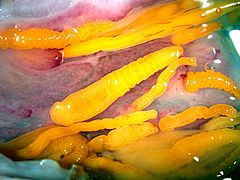Acanthocephala facts for kids
The Acanthocephala are a fascinating group of parasitic worms. They are often called thorny-headed worms or spiny-headed worms. Their name comes from Greek words: akanthos meaning "thorn" and kephale meaning "head".
These worms have a special part called a proboscis. It's like a retractable snout covered in sharp spines. They use this spiny proboscis to grab onto the inside wall of their host's gut. Thorny-headed worms don't have a gut of their own. Instead, they soak up all the nutrients they need directly from the host's gut.
Acanthocephalans have complicated life cycles. They often need different hosts to complete their journey from young to adult. These hosts can include invertebrates like crustaceans and insects. As adults, they usually live inside the digestive system of vertebrates, especially fishes. They can also be found in amphibians, birds, and mammals. Scientists have described about 1150 different kinds of these worms.
Quick facts for kids Acanthocephala |
|
|---|---|
 |
|
| Scientific classification | |
| Kingdom: | |
| Subkingdom: | |
| (unranked): | |
| Superphylum: | |
| Phylum: |
Acanthocephala (but see text)
Kohlreuther, 1771
|
Contents
What Makes Thorny-Headed Worms Unique?
Thorny-headed worms are special because of their spiny proboscis. This part can be pushed out or pulled back in. It helps them attach firmly to the host's gut wall. This way, they can stay in place and absorb food.
Another unique thing about them is that they don't have a mouth or a digestive system. Unlike most animals that eat food, thorny-headed worms simply absorb nutrients through their skin. It's like their whole body acts as a sponge!
How Do Thorny-Headed Worms Live?
The life of a thorny-headed worm is quite an adventure, involving several different animals.
- It usually starts with a young worm living inside an invertebrate, like a tiny crustacean or an insect.
- When an animal like a fish eats that infected invertebrate, the young worm moves into its new host.
- Inside the fish (or bird, or mammal), the worm grows into an adult. The adult worm then lives in the host's gut.
- Adult worms lay eggs, which are then released from the host's body. These eggs can then be eaten by another invertebrate, starting the cycle all over again.
Are Thorny-Headed Worms Related to Other Animals?
For a long time, scientists thought thorny-headed worms were a completely separate group of animals called a phylum. But with new technology, scientists can now look closely at the DNA of different creatures. This is called genome analysis.
Recent studies using genome analysis have shown something surprising. Thorny-headed worms are actually very closely related to tiny animals called rotifers. Rotifers are usually free-living, meaning they don't live inside other animals.
Scientists believe that all parasites, like the thorny-headed worms, came from ancestors that lived freely. So, it seems that thorny-headed worms are actually rotifers that have changed over time to become parasites. This is a great example of how phylogenetics, which is the study of how living things are related, helps us understand the history of life on Earth. Because of these new discoveries, thorny-headed worms might soon be placed in a different taxonomic rank within the rotifer group, perhaps as a sub-phylum or a class.
Images for kids
-
Adult Pomphorhynchus in a bluefish
See also
 In Spanish: Acanthocephala para niños
In Spanish: Acanthocephala para niños




